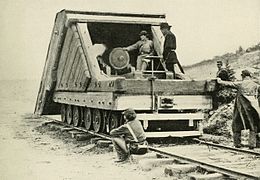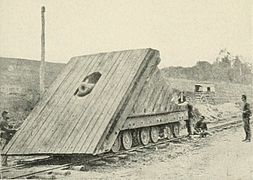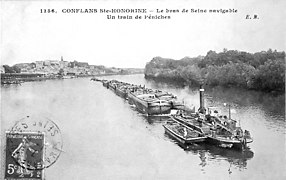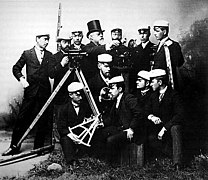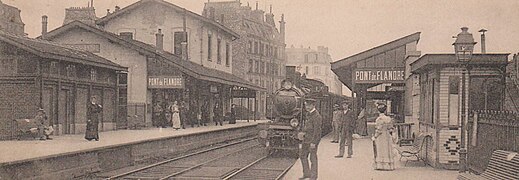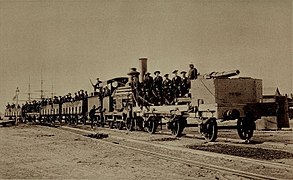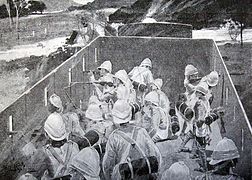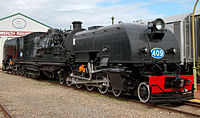Rail transportation in Burgundie: Difference between revisions
mNo edit summary Tag: 2017 source edit |
Aut-some chain boat lore Tag: 2017 source edit |
||
| (39 intermediate revisions by 2 users not shown) | |||
| Line 3: | Line 3: | ||
| name = Rail transport in Burgundie | | name = Rail transport in Burgundie | ||
| color = | | color = | ||
| logo = | | logo = CF Burg logo.png | ||
| image = | | image = File:GT26CW2-IR701.jpg | ||
| caption = | | caption = Busy rail corridor with both passenger and freight traffic | ||
| nationalrailway = | | nationalrailway = | ||
| infrastructure = | | infrastructure = | ||
| Line 13: | Line 13: | ||
| freight = | | freight = | ||
| length = | | length = | ||
* | *155,130km [[Burgoignesc Metropole]] | ||
* | *21,404km [[Equatorial Ostiecia]] | ||
* | *45,408km [[BORA]] | ||
'''TOTAL''': 221,942km | |||
| doublelength = | | doublelength = | ||
*86,183km [[Burgoignesc Metropole]] | |||
*11,891km [[Equatorial Ostiecia]] | |||
*TBD [[BORA]] | |||
'''TOTAL''': 98,074km+ | |||
| ellength = | | ellength = | ||
*78,746km [[Burgoignesc Metropole]] | |||
*13,377km [[Equatorial Ostiecia]] | |||
*30,272km [[BORA]] | |||
'''TOTAL''': 122,395km | |||
| freightlength = | | freightlength = | ||
| hslength = | | hslength = | ||
*14,193km [[Burgoignesc Metropole]] | |||
*1,070km [[Equatorial Ostiecia]] | |||
*0km [[BORA]] | |||
'''TOTAL''': 15,263km | |||
| gauge = {{wp|Standard gauge}} | | gauge = {{wp|Standard gauge}} | ||
| hsgauge = | | hsgauge = | ||
| gauge1 = | | gauge1 = | ||
| gauge1length = | | gauge1length = | ||
| el = | | el = | ||
| el1 = | | el1 = | ||
| el1length = | | el1length = | ||
| Line 55: | Line 68: | ||
==History== | ==History== | ||
===To | ===To 1848=== | ||
=== | The statelets of [[Maritime Dericania]] ([[Burgundie]]) were sluggards in building railways, compared to [[Urcea]] and the rest of the interior of [[Kingdom of Dericania]] which had already demonstrated their worthiness by [[1830]]. Due to the [[Burgundie|Burgoignesc]] tradition of [[Culture_in_Burgundie#Hyper-Urbanization|hyper-urbanization]], urban land was expensive, as was iron and {{wp|anthracite}} (preferred over the [[Energy_policy_in_Burgundie#History|lignite coal common]] in [[Maritime Dericania]]). A more serious obstacle was powerful political opposition, especially as mobilized by the principalities transport companies that used canals, roads, and rivers. They blocked the necessary railway charters. Mining companies in [[Faramount]], in [[1828]], opened the first railway to move coal, most of the work was done by horses, although steam locomotives were used for the last segment. Passenger service opened in [[1835]]. Rail was invested in by dukes and counts as a personal hobby leading to a wide variety of gauges, lengths of rail, and types of rail service. It wasn't until the [[First Fratricide]] and the use of rail for military purposes by the more standardized and unified interior states of [[Kingdom of Dericania]] the that new state of [[Burgundie]] could no longer avoid the obvious need for a grand rail infrastructure, unified by more standardized gauges, regulated and inspected by the government but owned and operated by the private sector. | ||
===1848-1875=== | |||
{{Further|First Fratricide}} | |||
<gallery mode="packed"> | <gallery mode="packed"> | ||
File:MovingBatteryPetersburg1864.jpg|Rear view of a rail battery during the [[First Fratricide]] | File:MovingBatteryPetersburg1864.jpg|Rear view of a rail battery during the [[First Fratricide]] | ||
File:SiegeGunPetersburg1864.jpg|Front view of a rail battery during the [[First Fratricide]] | File:SiegeGunPetersburg1864.jpg|Front view of a rail battery during the [[First Fratricide]] | ||
File:Frank_Leslie's_Illustrated_Newspaper_-_18610518_-_p1_-_Railroad_Battery.png|Brugo-Faramountesc ''rail cruiser'' during the [[First Fratricide]] | File:Frank_Leslie's_Illustrated_Newspaper_-_18610518_-_p1_-_Railroad_Battery.png|Brugo-Faramountesc ''rail cruiser'' during the [[First Fratricide]] | ||
</gallery> | |||
The People's Spring of 1848 initially disrupted ongoing railway projects. Political instability and social unrest across [[Maritime Dericania]] put a temporary halt to investments and construction activities. Despite the initial hesitation, the revolution ultimately triggered a shift in government policy towards rail infrastructure. [[List_of_Rulers_of_Burgundie#Bourgondii_Marius_Dynasty|Paul II]] put a focus on economic revival and job creation, recognized the potential of railways to stimulate the [[Duchy of Bougondi]]'s economy, as well as Duke Reginauld IV of the [[Duchy of Martilles]], and Prince Alie III of the [[Principality of Faramount]]. As a result these governments began playing a more active role in promoting railway development. This included providing loans and subsidies to private companies to overcome financial hurdles and support private sector construction. These plans often prioritized connecting major economic hubs to their principal cities and ports, creating a more integrated transportation network across their states. They tried to address some of the pre-existing issue of a disjointed network built primarily for the operator's profit, rather than national interests. In some places, like the [[Duchy of Bourgondi]], regulations were implemented to ensure technical compatibility between different railway lines constructed by various private companies. This move addressed inconsistencies in track gauges, signaling systems, and locomotive specifications, and fostered a more efficient movement of goods and people across the network. Construction of tracks, stations, and bridges created significant job opportunities in the construction industry. This not only bolstered the economies of [[Maritime Dericania]] but also provided a valuable source of income for the working class, a key concern of the 1848 revolution. | |||
The [[First_Fratricide#Bourgondii-Verecundian_War|Bourgondii-Verecundian War]], which later escalated into the [[First Fratricide]], dealt a major blow to these railway systems. Many railway lines, stations, and bridges were destroyed during the fighting. The far superior and interconnected rail systems of the interior of the [[Kingdom of Dericania]] proved to the [[Bergendii]] that it was time to embrace railways wholeheartedly in the post-war period. | |||
====Chain boats==== | |||
<gallery mode="packed"> | |||
File:Toueur.jpg | |||
Vendhuile (Aisne) - Entrée du canal souterrain et le toueur électrique.jpg | |||
Prokudin-Gorskii toueur and barges.jpg | |||
CanalStQuentin1.jpg | |||
Die Kettenschleppschiffahrt Illustrirte Zeitung Seite 80.png | |||
</gallery> | |||
From the 1850s through the 1930s, many rail freight companies used {{wp|chain boats}} to supplement their rail lines, especially in areas Upland mining communities were they had not yet built lines, or they were not deemed profitable. These {{wp|chain boats}} were vital both as a stop gap and also as a stand-alone mode of transit. There were even some communities that operated municipal {{wp|chain boat}} towing services to bring passengers, farmers, and workers back upstream after they had completed self-propelled journeys downstream. Because of the negligible investment capital required to start a {{wp|chain boat}} line, compared to rail, they were also used to survey potential demand for future rail lines for both passengers and cargo. | |||
In the immediate aftermath of the [[First Fratricide]], when [[Burgundie]] was formed and their coffers were almost empty, {{wp|chain boat}} usage peaked in [[Burgundie]]. From [[1877]]-[[1902]] {{wp|chain boats}} moved more cargo and people than rail did, but the technology couldn't keep up with the pace of progress and with the [[Great Depression]] and the desire to create public works projects, the {{wp|chain boat}} fell out of fashion and by the 1930s very few of them were still in operation. | |||
===1876-1896=== | |||
<gallery mode="packed"> | |||
File:Tkkstudentsbackinthedays.jpg|Young surveyors of the [[Grand Corps of Civil Engineers of the Nation of Burgundie|Department of Bridges, Tunnels, and Waterways]]. | |||
File:Viaduc_du_Point_du_Jour_-_Les_Travaux_Publics_de_la_France.jpg|Rail viaduct created in the 1880s | |||
File:Boer_Ceinture_29.jpg|Passenger train in the 1890s | |||
File:Gare_Avenue_Clichy.jpg|Suburban rail platform of the era | |||
File:Gare_Pont_Flandre.jpg|Urban rail platform of the era | |||
</gallery> | |||
The 1877 Agreement for the Development of the Railway of Burgundie, called for the state to contribute about $50,000 per mile and own the system. At the time, private companies spent about $40,000 per mile for track, equipment, buildings, locomotives, and cars. The government further subsidized the companies by having the [[Grand Corps of Civil Engineers of the Nation of Burgundie|Department of Bridges, Tunnels, and Waterways]] do most of the planning and engineering work for new lines. The government would assist in securing the land, often by {{wp|expropriation}}, especially of lands owned by [[Dericania]]ns. The government also agreed to pay infrastructure costs, building bridges, tunnels, and track bed. The private companies would then furnish the tracks, stations and rolling stock, as well as pay the operating costs. The policy was confusing and contradictory, and blocked monopolies, which meant no regional networks could form. | |||
This general policy masked many exceptions and additions. The most successful companies would often build their own lines themselves in order to avoid the complications of going through the government. For instance, during the economic boom period of the 1880s, the national government had to pay only 19 percent of the costs of railway construction. Other less successful lines would often need more assistance from the government to remain in operation. The same proved true during recessions, such as in [[1892]], when the railway lines gained a new agreement to save them from bankruptcy. In exchange for funding part of the construction of rail lines, the [[Government of Burgundie]] set maximum rates that the companies could charge. It also insisted that all government and military traffic must travel at a third of standard costs. | |||
The expectation that the government would eventually nationalize the rail system formed another important element in [[Burgundie|Burgoignesc]] railway legislation. That the rail companies only operated on leases paved the way for the nationalization of the [[Burgundie|Burgoignesc]] rail lines during the [[Second Great War]]. | |||
===1896-1902=== | |||
{{Further|First Great War}} | |||
<gallery mode="packed"> | |||
File:British_troop_train_in_Egypt_1882_cropped.jpg|Depiction of a [[Burgundie|Burgoignesc]] armored train during the [[First Great War]] | File:British_troop_train_in_Egypt_1882_cropped.jpg|Depiction of a [[Burgundie|Burgoignesc]] armored train during the [[First Great War]] | ||
File:The_Armed_Train_at_Alexandria.jpg|Photograph of a [[Burgundie|Burgoignesc]] armored train during the [[First Great War]] | File:The_Armed_Train_at_Alexandria.jpg|Photograph of a [[Burgundie|Burgoignesc]] armored train during the [[First Great War]] | ||
File:Armoured_train_1899-2.jpg|Depiction of a [[Burgundie|Burgoignesc]] armored train during the [[First Great War]] | File:Armoured_train_1899-2.jpg|Depiction of a [[Burgundie|Burgoignesc]] armored train during the [[First Great War]] | ||
</gallery> | </gallery> | ||
The [[First Great War]] highlighted the need for similar levels of investment in rail infrastructure in [[Equatorial Ostiecia]] and the islands of [[BORA]]. It also became a key period for the development of intracity light transit. The {{wp|Chemin de fer de Petite Ceinture}} built in [[Vilauristre]] to supply the [[Vilauristre#Vilauristre_Defensive_Positions|Vilauristre Defensive Positions]], was later remanded to public use and eventually became what is today [[Vilauristre#ViaVille]]. It was also during this time that passenger rail traffic and development became the priority, as the [[Government of Burgundie]] had focused its efforts on connecting industry, mining, and key agricultural centers to the ports and major cities of the [[Burgoignesc Metropole]]. | |||
===1897-1934=== | ===1897-1934=== | ||
===1934- | ====Great Depression==== | ||
{{wp|Great Depression}} | |||
During the [[Great Depression]] the [[Government of Burgundie]] nationalized the passenger rails as the individual companies went bankrupt to maintain the ability of people to move to where the work was and to move the [[ Corps of Burgundie]] to the places where there would be new projects. Many projects were building new railroads, tunnels, and bridges with the [[Grand Corps of Civil Engineers of the Nation of Burgundie]]. | |||
===1934-1944=== | |||
{{Further|Second Great War}} | |||
<gallery mode="packed"> | <gallery mode="packed"> | ||
File:French_190_mm_gun_on_armored_train_1917_AWM_H04529.jpeg|190mm railway gun during the [[Second Great War]] | File:French_190_mm_gun_on_armored_train_1917_AWM_H04529.jpeg|190mm railway gun during the [[Second Great War]] | ||
| Line 75: | Line 130: | ||
File:Train_hostages.jpg|[[Burgundie|Burgoignesc]] armored train in [[Battganuur]] during the [[Second Great War]] | File:Train_hostages.jpg|[[Burgundie|Burgoignesc]] armored train in [[Battganuur]] during the [[Second Great War]] | ||
</gallery> | </gallery> | ||
===1980- | During the [[Second Great War]] most of the freight lines were nationalized to support the movement of troops and armored vehicles. | ||
===1945-1980=== | |||
{{Further|Occidental Cold War|Operation Kipling|History_of_Burgundie#The_Great_Tumult|History_of_Burgundie#Second_Burgundian_Renaissance}} | |||
It is impossible to downplay the {{wp|Societal impacts of cars|role of the automobile}} and the {{wp|Interstate Highway System}} in the second half of the 20th century and its negative impact on rail transportation sector. While key elements of society still used trains to travel for both goods and passengers, the 1950s-1980s were a period of stagnation for rail transportation in [[Burgundie]]. Almost no new rail was laid in the [[Burgoignesc Metropole]] in this period. Rail did see a small revival in the 1960s with the escalation of the [[Occidental Cold War]], with the creation of the [[Government_of_Burgundie#Strategic_Auxiliary_Fleet_of_the_Continuation|Strategic Auxiliary Fleet of the Continuation]], a reserve fleet of steam locomotives train engines, steam ships, and clipper ships owned by the [[Government of Burgundie#Emergency Management|Ministry of Emergency Management]]. This fleet is widely distributed across the [[Burgoignesc Metropole]] in the event of a nuclear strike. Due to the mechanical nature of these modes of transportation they would not be impacted by an electro-magnetic pulse (EMP) of a nuclear detonation and would be the primary mode of transportation for key royal and national government officials reconstituting or for troop movements. | |||
[[Containerization]] is considered the saving grace of the freight rail network in [[Burgundie]], especially in [[Equatorial Ostiecia]]. Starting in the 70s, ports across the [[Burgoignesc thalattocracy]] received significant and recurrent updates to accommodate {{wp|intermodal}} {{wp|transshipment}} which always prioritized rail. | |||
===1980-1999=== | |||
<gallery mode="packed"> | <gallery mode="packed"> | ||
File:Train_blindé_au_musée_ferroviaire_de_Windhoek.jpg | File:Train_blindé_au_musée_ferroviaire_de_Windhoek.jpg|Army Corps of the Rails armored troop transport wagon | ||
</gallery> | </gallery> | ||
BurgunFri movement gives rise to more passenger traffic, advanced stage containerization gives rise to more freight traffic, and highspeed trains as an option gets people excited about rail again. Increased standardization with the rest of the [[Levantine Union]] makes travel more efficient and cheaper. | |||
===21st century=== | |||
*[[21st_Century_Burgoignesc_Power_Projection_Stratagem#Passenger_Rail_Corridor_Identification_and_Development_Program|Passenger Rail Corridor Identification and Development Program in Burgundie]] | *[[21st_Century_Burgoignesc_Power_Projection_Stratagem#Passenger_Rail_Corridor_Identification_and_Development_Program|Passenger Rail Corridor Identification and Development Program in Burgundie]] | ||
*[[Levantine_Union#Passenger_Rail_Corridor_Identification_and_Development_Program|Passenger Rail Corridor Identification and Development Program in the Levantine Union]] | *[[Levantine_Union#Passenger_Rail_Corridor_Identification_and_Development_Program|Passenger Rail Corridor Identification and Development Program in the Levantine Union]] | ||
*[[Flight shame]] | *[[Flight shame]] | ||
Increased automation makes trains faster and safer, additional environmental concerns push more passengers to rail, globalization (especially e-commerce) drives freight traffic through the roof. | |||
==Freight railroads== | ==Freight railroads== | ||
| Line 122: | Line 191: | ||
*[[Army_of_Burgundie#Army_Corps_of_the_Rails|Army Corps of the Rails]] | *[[Army_of_Burgundie#Army_Corps_of_the_Rails|Army Corps of the Rails]] | ||
==See also== | ==See also== | ||
*[[Order_of_the_Obsidian_Sparrow#Logistics]] | *[[Order_of_the_Obsidian_Sparrow#Logistics]] | ||
*[[Economy of Burgundie]] | *[[Economy of Burgundie]] | ||
*[[Rail transport in Cartadania]] | |||
*[[Rail transport in Kiravia]] | |||
*[[Railway transport in Pelaxia]] | |||
*[[Rail transportation in Urcea]] | |||
*[[Arco National Railway Service]] | |||
*[[Caphiria Express Lionized Electric Rail]] | |||
*[[Ferrovia Imperiale]] | |||
*[[KirRail]] | |||
*[[Yonderrail]] | |||
{{Burgundie NavBox}} | {{Burgundie NavBox}} | ||
[[Category: Economy]] | [[Category: Economy]] | ||
[[Category: Burgundie]] | [[Category: Burgundie]] | ||
[[Category: IXWB]] | {{Template:Award winning article}} | ||
[[Category:2024 Award winning pages]] | |||
[[Category:IXWB]] | |||
[[Category:Railways]] | [[Category:Railways]] | ||
[[Category:Economy of Burgundie]] | [[Category:Economy of Burgundie]] | ||
Latest revision as of 11:48, 18 June 2024
This article is a work-in-progress because it is incomplete and pending further input from an author. Note: The contents of this article are not considered canonical and may be inaccurate. Please comment on this article's talk page to share your input, comments and questions. |
| Rail transport in Burgundie | |
|---|---|
 | |
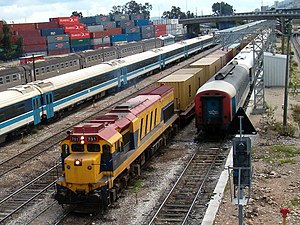 Busy rail corridor with both passenger and freight traffic | |
| System length | |
| Total |
|
| Double track |
|
| Electrified |
|
| High-speed |
|
| Track gauge | |
| Main | Standard gauge |
| This article is part of a series on the |
| Economy of Burgundie |
|---|
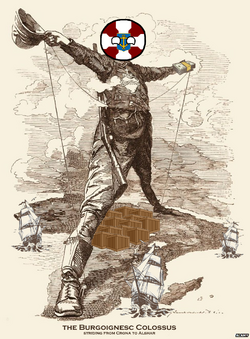 |
| Economy |
| Policies |
| Alliances and Trade Agreements |
| History and culture |
| Key components |
|
Burgundie portal |
| Business logistics |
|---|
| Distribution methods |
| Management systems |
| Industry classification |
| Historical business logistics |
|
Rail transportation in Burgundie consists primarily of freight shipments, with a well integrated network of standard gauge private freight railroads extending throughout the Levantine Union. Passenger service is mainly mass transit and commuter rail in major cities. Intercity passenger service, once a large and vital part of the nation's passenger transportation network, plays a limited role but is making a comeback after the passage of the Passenger Rail Corridor Identification and Development Program in 2030. Burgundie has a large rail transport network and the vast majority of its internal freight is conveyed directly by rail.
Since 2000, significant efforts have been made to electrify Burgundie's rail transportation system, taking advantage of the cheap and plentiful nuclear and renewable power available throughout the nation while also attempting to reduce carbon emissions. Rail continues to play a major role in the Burgoignesc economy in the 21st century.
Governance
Ownership
In Burgundie, all railways are owned by the Army Corps of the Rails (15%) and , particularly the national government. This includes the physical track, infrastructure supporting the right of ways, signal switches, and all other directly related physical infrastructure. The government also operates the signal switches and is responsible for overseeing traffic along the rails, coordinating and prioritizing trains throughout the nation and ensuring efficient travel. The vehicles themselves and any railyards responsible for their maintenance and storage are owned by private firms who operate the railways. Accordingly, the Burgoignesc rail network operates on a public-private partnership, with the government owning and paying for the maintenance of the physical infrastructure while private companies operate and compete on the public rails.
Regulation
The publicly owned rail system is operated by the Burgoignesc Rail Transportation Amenity (Burg: Commoditee des chemins de fer Burgoignesc (CCFB)), and the system - as well as all private operators on it - is overseen by the National Railroad Administration (Burg: Administration nationale des chemins de fer de Burgundie (ANCFB)).
History
To 1848
The statelets of Maritime Dericania (Burgundie) were sluggards in building railways, compared to Urcea and the rest of the interior of Kingdom of Dericania which had already demonstrated their worthiness by 1830. Due to the Burgoignesc tradition of hyper-urbanization, urban land was expensive, as was iron and anthracite (preferred over the lignite coal common in Maritime Dericania). A more serious obstacle was powerful political opposition, especially as mobilized by the principalities transport companies that used canals, roads, and rivers. They blocked the necessary railway charters. Mining companies in Faramount, in 1828, opened the first railway to move coal, most of the work was done by horses, although steam locomotives were used for the last segment. Passenger service opened in 1835. Rail was invested in by dukes and counts as a personal hobby leading to a wide variety of gauges, lengths of rail, and types of rail service. It wasn't until the First Fratricide and the use of rail for military purposes by the more standardized and unified interior states of Kingdom of Dericania the that new state of Burgundie could no longer avoid the obvious need for a grand rail infrastructure, unified by more standardized gauges, regulated and inspected by the government but owned and operated by the private sector.
1848-1875
-
Rear view of a rail battery during the First Fratricide
-
Front view of a rail battery during the First Fratricide
-
Brugo-Faramountesc rail cruiser during the First Fratricide
The People's Spring of 1848 initially disrupted ongoing railway projects. Political instability and social unrest across Maritime Dericania put a temporary halt to investments and construction activities. Despite the initial hesitation, the revolution ultimately triggered a shift in government policy towards rail infrastructure. Paul II put a focus on economic revival and job creation, recognized the potential of railways to stimulate the Duchy of Bougondi's economy, as well as Duke Reginauld IV of the Duchy of Martilles, and Prince Alie III of the Principality of Faramount. As a result these governments began playing a more active role in promoting railway development. This included providing loans and subsidies to private companies to overcome financial hurdles and support private sector construction. These plans often prioritized connecting major economic hubs to their principal cities and ports, creating a more integrated transportation network across their states. They tried to address some of the pre-existing issue of a disjointed network built primarily for the operator's profit, rather than national interests. In some places, like the Duchy of Bourgondi, regulations were implemented to ensure technical compatibility between different railway lines constructed by various private companies. This move addressed inconsistencies in track gauges, signaling systems, and locomotive specifications, and fostered a more efficient movement of goods and people across the network. Construction of tracks, stations, and bridges created significant job opportunities in the construction industry. This not only bolstered the economies of Maritime Dericania but also provided a valuable source of income for the working class, a key concern of the 1848 revolution.
The Bourgondii-Verecundian War, which later escalated into the First Fratricide, dealt a major blow to these railway systems. Many railway lines, stations, and bridges were destroyed during the fighting. The far superior and interconnected rail systems of the interior of the Kingdom of Dericania proved to the Bergendii that it was time to embrace railways wholeheartedly in the post-war period.
Chain boats
From the 1850s through the 1930s, many rail freight companies used chain boats to supplement their rail lines, especially in areas Upland mining communities were they had not yet built lines, or they were not deemed profitable. These chain boats were vital both as a stop gap and also as a stand-alone mode of transit. There were even some communities that operated municipal chain boat towing services to bring passengers, farmers, and workers back upstream after they had completed self-propelled journeys downstream. Because of the negligible investment capital required to start a chain boat line, compared to rail, they were also used to survey potential demand for future rail lines for both passengers and cargo.
In the immediate aftermath of the First Fratricide, when Burgundie was formed and their coffers were almost empty, chain boat usage peaked in Burgundie. From 1877-1902 chain boats moved more cargo and people than rail did, but the technology couldn't keep up with the pace of progress and with the Great Depression and the desire to create public works projects, the chain boat fell out of fashion and by the 1930s very few of them were still in operation.
1876-1896
-
Young surveyors of the Department of Bridges, Tunnels, and Waterways.
-
Rail viaduct created in the 1880s
-
Passenger train in the 1890s
-
Suburban rail platform of the era
-
Urban rail platform of the era
The 1877 Agreement for the Development of the Railway of Burgundie, called for the state to contribute about $50,000 per mile and own the system. At the time, private companies spent about $40,000 per mile for track, equipment, buildings, locomotives, and cars. The government further subsidized the companies by having the Department of Bridges, Tunnels, and Waterways do most of the planning and engineering work for new lines. The government would assist in securing the land, often by expropriation, especially of lands owned by Dericanians. The government also agreed to pay infrastructure costs, building bridges, tunnels, and track bed. The private companies would then furnish the tracks, stations and rolling stock, as well as pay the operating costs. The policy was confusing and contradictory, and blocked monopolies, which meant no regional networks could form. This general policy masked many exceptions and additions. The most successful companies would often build their own lines themselves in order to avoid the complications of going through the government. For instance, during the economic boom period of the 1880s, the national government had to pay only 19 percent of the costs of railway construction. Other less successful lines would often need more assistance from the government to remain in operation. The same proved true during recessions, such as in 1892, when the railway lines gained a new agreement to save them from bankruptcy. In exchange for funding part of the construction of rail lines, the Government of Burgundie set maximum rates that the companies could charge. It also insisted that all government and military traffic must travel at a third of standard costs. The expectation that the government would eventually nationalize the rail system formed another important element in Burgoignesc railway legislation. That the rail companies only operated on leases paved the way for the nationalization of the Burgoignesc rail lines during the Second Great War.
1896-1902
-
Depiction of a Burgoignesc armored train during the First Great War
-
Photograph of a Burgoignesc armored train during the First Great War
-
Depiction of a Burgoignesc armored train during the First Great War
The First Great War highlighted the need for similar levels of investment in rail infrastructure in Equatorial Ostiecia and the islands of BORA. It also became a key period for the development of intracity light transit. The Chemin de fer de Petite Ceinture built in Vilauristre to supply the Vilauristre Defensive Positions, was later remanded to public use and eventually became what is today Vilauristre#ViaVille. It was also during this time that passenger rail traffic and development became the priority, as the Government of Burgundie had focused its efforts on connecting industry, mining, and key agricultural centers to the ports and major cities of the Burgoignesc Metropole.
1897-1934
Great Depression
Great Depression During the Great Depression the Government of Burgundie nationalized the passenger rails as the individual companies went bankrupt to maintain the ability of people to move to where the work was and to move the Corps of Burgundie to the places where there would be new projects. Many projects were building new railroads, tunnels, and bridges with the Grand Corps of Civil Engineers of the Nation of Burgundie.
1934-1944
-
190mm railway gun during the Second Great War
-
Railway gun battery during the Second Great War
-
320mm railway railway gun during the Second Great War
-
400mm railway gun during the Second Great War
During the Second Great War most of the freight lines were nationalized to support the movement of troops and armored vehicles.
1945-1980
It is impossible to downplay the role of the automobile and the Interstate Highway System in the second half of the 20th century and its negative impact on rail transportation sector. While key elements of society still used trains to travel for both goods and passengers, the 1950s-1980s were a period of stagnation for rail transportation in Burgundie. Almost no new rail was laid in the Burgoignesc Metropole in this period. Rail did see a small revival in the 1960s with the escalation of the Occidental Cold War, with the creation of the Strategic Auxiliary Fleet of the Continuation, a reserve fleet of steam locomotives train engines, steam ships, and clipper ships owned by the Ministry of Emergency Management. This fleet is widely distributed across the Burgoignesc Metropole in the event of a nuclear strike. Due to the mechanical nature of these modes of transportation they would not be impacted by an electro-magnetic pulse (EMP) of a nuclear detonation and would be the primary mode of transportation for key royal and national government officials reconstituting or for troop movements.
Containerization is considered the saving grace of the freight rail network in Burgundie, especially in Equatorial Ostiecia. Starting in the 70s, ports across the Burgoignesc thalattocracy received significant and recurrent updates to accommodate intermodal transshipment which always prioritized rail.
1980-1999
-
Army Corps of the Rails armored troop transport wagon
BurgunFri movement gives rise to more passenger traffic, advanced stage containerization gives rise to more freight traffic, and highspeed trains as an option gets people excited about rail again. Increased standardization with the rest of the Levantine Union makes travel more efficient and cheaper.
21st century
- Passenger Rail Corridor Identification and Development Program in Burgundie
- Passenger Rail Corridor Identification and Development Program in the Levantine Union
- Flight shame
Increased automation makes trains faster and safer, additional environmental concerns push more passengers to rail, globalization (especially e-commerce) drives freight traffic through the roof.
Freight railroads
Freight rail is the major method of logistical transport within the Burgundie, and presents the primary way most goods move around the nation, ranging from military applications to the conveyance of retail goods. A combination of historic urban planning after the First and Second Great Wars and more recent consumer buying habits have meant most major warehouses in Burgundie are built directly adjoining the nation's freight lines, allowing for easy loading and offloading of goods.
Strategic Auxiliary Fleet of the Continuation
The Strategic Auxiliary Fleet of the Continuation is a reserve fleet of steam locomotives train engines, steam ships, and clipper ships owned by the Ministry of Emergency Management. This fleet is widely distributed across the Burgoignesc Metropole in the event of a nuclear strike. Due to the mechanical nature of these modes of transportation they would not be impacted by an electro-magnetic pulse (EMP) of a nuclear detonation and would be the primary mode of transportation for key royal and national government officials reconstituting or for troop movements.
The rail fleet is maintained by the Army Corps of the Rails and the ship fleet is maintained by Merchant Marine of Burgundie. To maintain operational readiness all of the Strategic Auxiliary Fleet of the Continuation vehicles are used on an at least quarterly basis.
Environmental concerns have plagued the steam engine program and there have been a number of scholarships given to universities and think-tanks to come up with a better, equally as accessible, and equally replenishable fuel, instead of coal.
- Strategic Auxiliary Fleet of the Continuation trains
Passenger railroads
Burgoignesc Rail Transportation Amenity
The Burgoignesc Rail Transportation Amenity (Burg: Commoditee des chemins de fer Burgoignesc (CCFB)), is the public sector, intercity, passenger rail operator in the Burgoignesc Metropole. It owns and operates all rail corridors, rights of way, and rolling stock that serve this purpose.
Equatorial Express
The Equatorial Express (Burg: Express Equatorial) is the public sector, intercity, passenger rail operator in Equatorial Ostiecia, Port de Vent, and Sudmoll. It owns and operates all rail corridors, rights of way, and rolling stock that serve this purpose.
Istroyan Rail
Istroyan Rail (Burg: Istroie Ferroviaire), is the public-private joint-venture, intercity, passenger rail operator in Torlen, Antilles, Alcairet, and Chaukhira. It owns and operates all rail corridors, rights of way, and rolling stock that serve this purpose.
Borail
Borail (a portmanteau of boreal and rail) is the is the public-private joint-venture, intercity, passenger rail operator in Nauta Normand and Wintergen. It owns and operates all rail corridors, rights of way, and rolling stock that serve this purpose.
Iles Evangeline
The passenger rail in Iles Evangeline is being completely rebuilt to implement standard gauge and establish greater connectivity for service. This work is planned to be completed by 2039 at which point it will become a unique rail service provider, a body that has not yet been formed.
Key operators and manufacturers
See also
- Order_of_the_Obsidian_Sparrow#Logistics
- Economy of Burgundie
- Rail transport in Cartadania
- Rail transport in Kiravia
- Railway transport in Pelaxia
- Rail transportation in Urcea
- Arco National Railway Service
- Caphiria Express Lionized Electric Rail
- Ferrovia Imperiale
- KirRail
- Yonderrail
